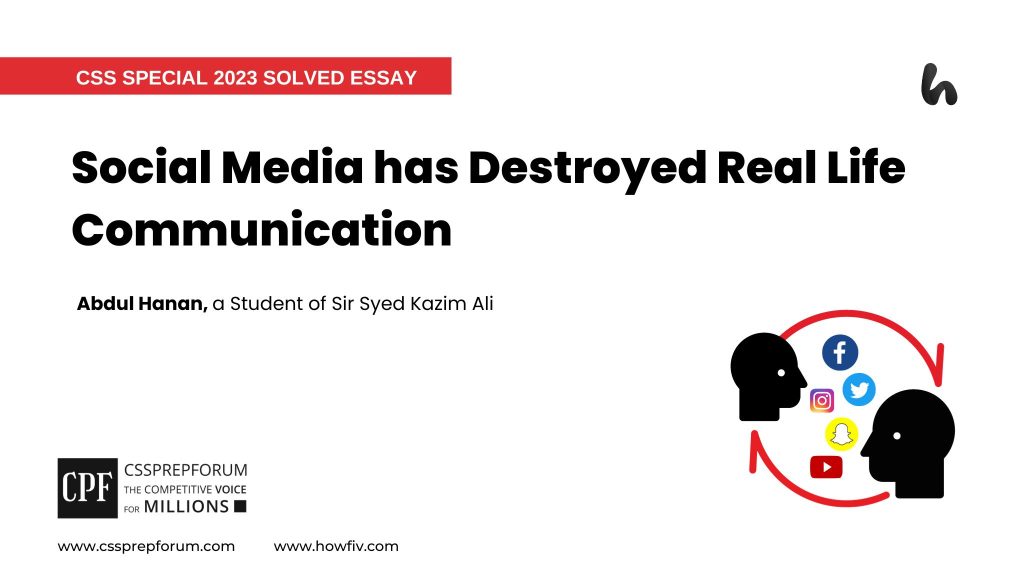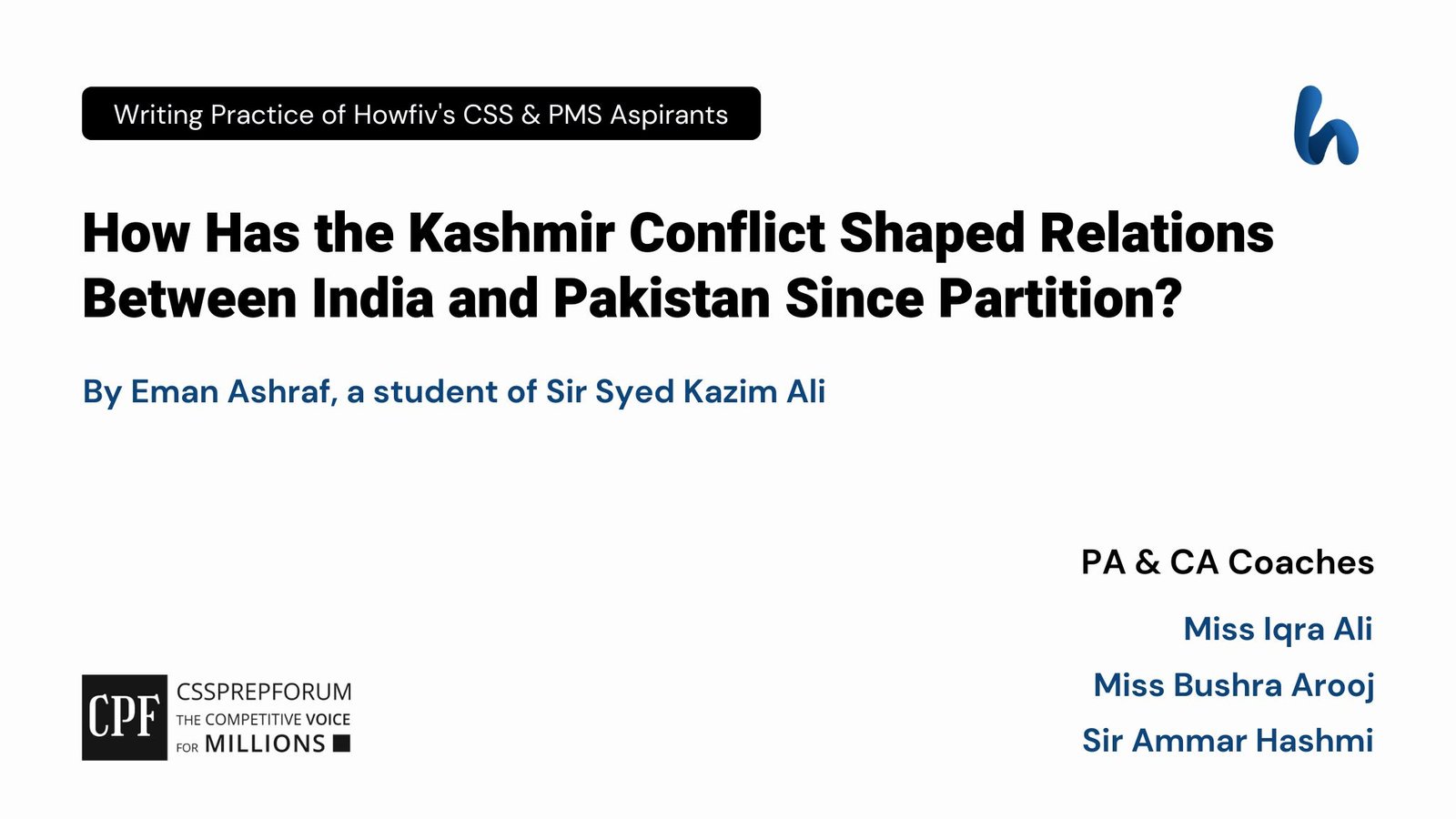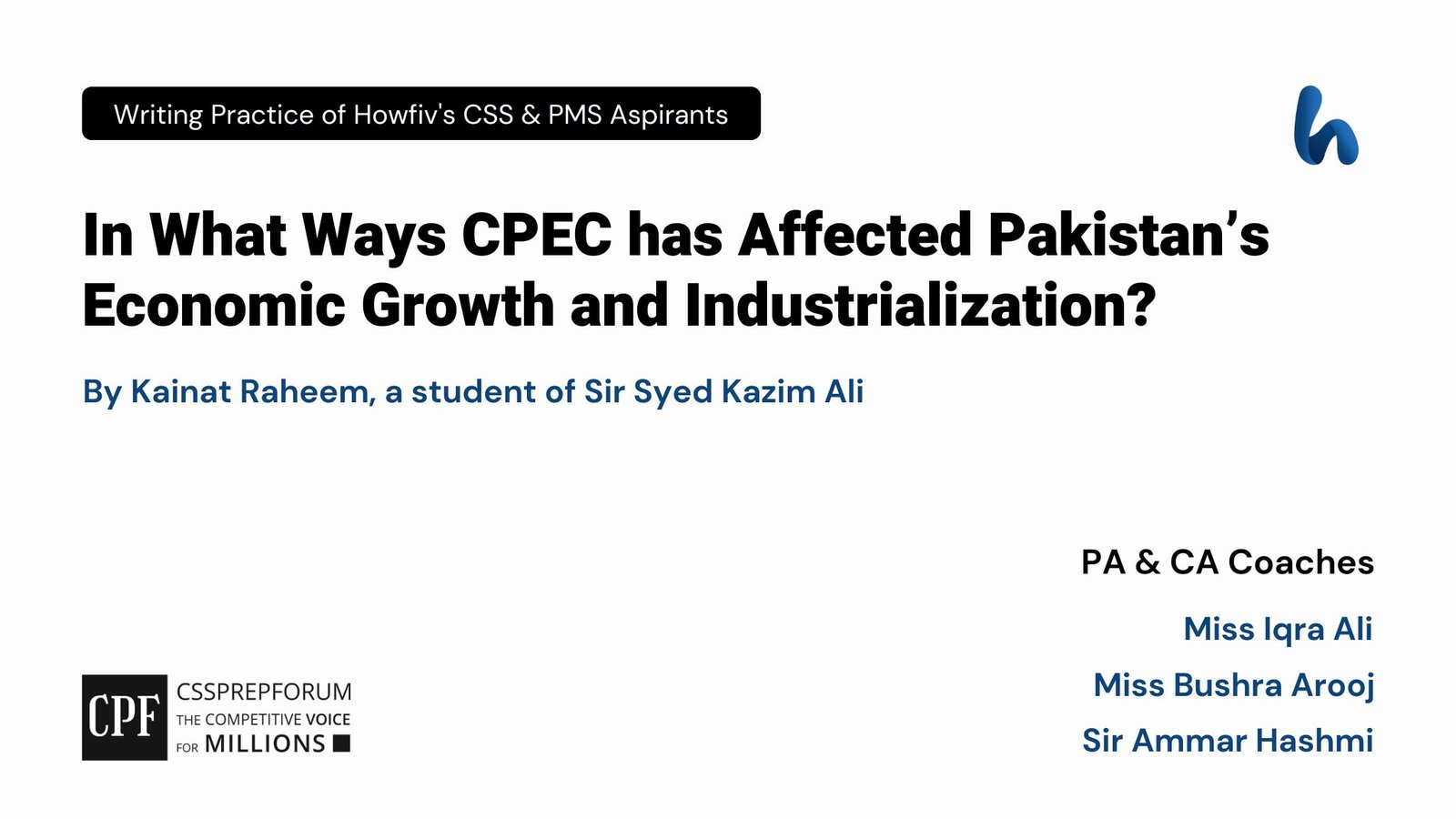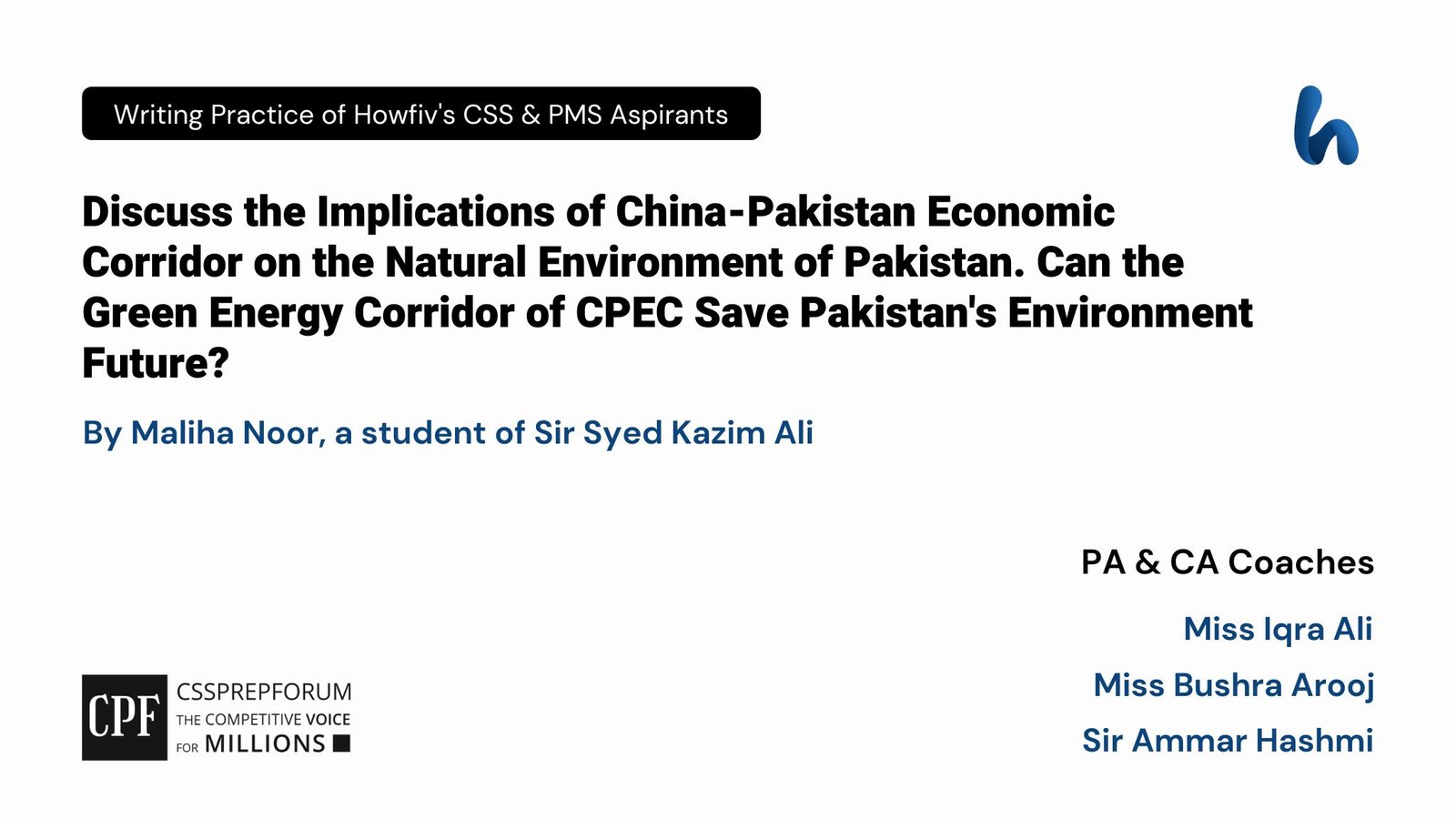CSS Special 2023 Solved Essays | Social Media Has Destroyed Real Life Communication
Abdul Hanan, a Sir Syed Kazim Ali student, has attempted the CSS Special 2023 essay “Social Media Has Destroyed Real Life Communication” on the given pattern, which Sir Syed Kazim Ali teaches his students. Sir Syed Kazim Ali has been Pakistan’s top English writing and CSS, PMS essay and precis coach with the highest success rate of his students. The essay is uploaded to help other competitive aspirants learn and practice essay writing techniques and patterns to qualify for the essay paper.

Outline
1- Introduction
Social media has eroded meaningful real-life communication, replacing it with shallow interactions and reducing face-to-face conversations. This shift has led to a decline in genuine human connections and empathy. Therefore, striking a balance between online and offline life is essential to preserve authentic dialogue and deep human connections.
2- The Changing Landscape of Communication
- Historical context of real-life communication
- Emergence of social media platforms
- The changing landscape of human interaction
3- How has social media contributed to the erosion of meaningful real-life communication?
- Decrease in face-to-face Communication
- Case in Point: A 2019 study by the Pew Research Center found that 53% of adults in the US say they spend too much time on their phones.
- Leading to Social Isolation
- Case in Point: A 2022 study by the University of Pennsylvania found that people who use social media for more than two hours per day are more likely to report feeling lonely and depressed.
- Difficult to focus on Real-Life Conversations
- Case in Point: A 2021 study by the University of Maryland found that people who use their phones during conversations are more likely to misunderstand what the other person is saying.
- Spreading of Misinformation and Disinformation
- Case in Point: A 2023 study published in the journal “Nature Human Behaviour” found that people who are exposed to misinformation on social media are more likely to believe it, even if it is later corrected.
- Propagating Addiction
- Case in Point: In 2020, the World Health Organization declared that social media addiction is a real mental health problem. The WHO defines social media addiction as “a pattern of persistent or recurrent use of social networking sites that is so severe that it causes significant impairment in personal, family, social, educational, occupational or other important areas of functioning.”
- Promoting FOMO (fear of missing out)
- Case in Point: A 2022 study by the University of California, Berkeley found that 69% of US adults experience FOMO on a regular basis.
- Decline in Empathy and Emotional Intelligence
- Case in Point: A 2019 study by the University of Michigan found that people who use social media more frequently are more likely to exhibit narcissistic behavior.
- Erosion of Traditional culture
- Case in Point: A 2019 study by the University of Oxford found that social media is promoting cultural homogenization. The study found that people who use social media more frequently are more likely to adopt Western cultural values and practices. The study also found that social media is making it difficult for people to maintain their traditional cultural identities.
4- How can social media serve as a supplement, rather than a replacement, for real-life communication?
- Maintaining and Nurturing Relationships
- Educational and Informative Interactions
- Promoting Hobbies, Interests, and Creativity
5- How can people mitigate the challenges posed by eroding meaningful real-life communication?
- To Raise Awareness and Educate
- To Promote Digital Detox
- To Encourage In-Person Interactions
- To Foster Active Listening and Empathy
6- Critical Analysis
7- Conclusion

Technology has revolutionized the way of communication, breaking barriers of distance and time. Beginning with the invention of the telephone and culminating in the pervasiveness of social media platforms, the communication landscape has evolved into a realm of instantaneity, global outreach, and unparalleled interconnectedness. Yet, in a paradoxical twist, social media, the very medium designed to enhance communication, has become a double-edged sword, leading to profound changes in the fabric of interpersonal relationships. Social media’s omnipresence and the allure of instant gratification have shifted the focus away from meaningful conversations to likes, retweets, and emojis. The relentless quest for online approval stifles genuine dialogue, contributing to the decline of real-life communication. Likewise, another facet of this deterioration is the reduction in face-to-face conversations. While digital communication is efficient, it often lacks the richness of non-verbal cues and the depth of personal connection that only face-to-face interactions can offer. As an addictive consequence of these trends, a noticeable decline is witnessed in genuine human connections and empathy. Moreover, in personal relationships, the ease of sending a message instead of engaging in a heartfelt conversation has led to shallow emotional connections; consequently, people are more connected than ever through social media but simultaneously more disconnected from the profound, empathetic interactions that sustain meaningful relationships. While social media profoundly affects real-life communication, leading to the erosion of face-to-face interactions, it can also serve as a supplement, fostering relationships, knowledge sharing, and shared interests. Therefore, striking a balance between online and offline lives is essential to preserving the authenticity of dialogue and the depth of human relationships. This essay highlights how social media has impacted real-life communication.
To begin with, it is pertinent to understand how the landscape of communication has evolved over the time. Throughout history, real-life communication has been the primary means by which people have interacted with each other. This has included face-to-face communication, as well as written communication through letters, diaries, and books. Real-life communication has played a crucial role in building relationships, sharing information, and shaping culture. The emergence of social media platforms in the early 2000s revolutionized the way we communicated. Platforms like Facebook, Twitter, and Instagram have made it possible for people to connect and share ideas with others from all over the world.
Read More
1- Social media has destroyed real life communication by Sumiya Amjad 2- Social media has destroyed real life communication by Abdul Hanan
This rise of social media platforms has had a profound impact on human interaction. It has made it easier for people to stay connected with friends and family members who live far away. It has also created new opportunities for people to connect with others who share their interests. According to DataReportal, there are 4.62 billion active social media users worldwide in October 2023. This means that over 58% of the world’s population is using social media. This highlights the significant impact that social media has had on the landscape of communication.
Paradoxically, social media, once hailed as the pinnacle of technological achievement in the realm of communication, has disrupted the age-old bond between individuals. It has become a double-edged sword, enabling virtual connections while eroding the value of real-life conversations. According to a 2019 study by the Pew Research Center, 53% of adults in the US say they spend too much time on their phones. Therefore, instead of engaging in in-person conversations and activities, individuals are increasingly glued to their screens, checking social media, and responding to digital messages. As a result, face-to-face communication, which is crucial for building deep and meaningful connections, is being supplanted by virtual interactions, ultimately eroding the quality and depth of real-life communication.
In addition, social media’s detrimental impact on individuals’ social lives is evident. It has led to social isolation, making it difficult to focus on real-life conversations, ultimately deteriorating real-life communication. According to a 2022 study conducted by the University of Pennsylvania, reveals that individuals who use social media for more than two hours per day are more likely to report feelings of loneliness and depression. It suggests a direct link between excessive social media use and a sense of isolation. As a result, it becomes increasingly challenging for individuals to engage in meaningful face-to-face interactions, ultimately diminishing the quality and depth of real-life conversations.
Likewise, the ubiquity of social media and its allure of instant gratification have redirected attention away from substantial face-to-face discussions towards the allure of likes, retweets, and emoji’s. This relentless pursuit of online validation stifles the essence of authentic dialogue and contributes to the erosion of genuine real-life communication. A 2021 study from the University of Maryland emphasized this concern by revealing that individuals who use their phones during conversations are more likely to misunderstand what the other person is saying. This underscores the adverse effects of divided attention, highlighting how technology, intended to connect humans, paradoxically hinders their ability to partake in meaningful and productive face-to-face conversations.
Adding more to it, the impact of social media on communication goes beyond casual conversation; it has evolved into a breeding ground for misinformation and disinformation, casting a shadow on public knowledge and discourse. In a recent study published in the prestigious journal “Nature Human Behaviour” in 2023, a disconcerting reality emerged: individuals exposed to false information on social media platforms display a significant inclination to accept and internalize such content, even when subsequently corrected. This alarming trend not only erodes trust but also impairs critical thinking, ultimately distorting the quality of face-to-face conversations. The concerning revelation underscores how social media’s role in propagating misinformation poses a substantial threat to authentic communication, rendering it increasingly challenging for individuals to engage in meaningful, well-informed discussions.
Similarly, the allure of social media’s addictive qualities has given rise to a troubling trend marked by compulsive usage, dependency, and the exacerbation of mental health disorders. Notably, in 2020, the World Health Organization officially recognized this issue, categorizing social media addiction as a legitimate mental health concern. Their definition, which characterizes it as “a pattern of persistent or recurrent use of social networking sites so severe that it causes significant impairment in personal, family, social, educational, occupational, or other important areas of functioning,” underscores the profound impact of digital platforms on individuals’ lives. This acknowledgment serves as a distressing illustration of how social media’s grip on society has contributed to the erosion of real-life communication skills, as people increasingly gravitate toward screens, forsaking the art of genuine face-to-face interactions.
Also, social media’s pervasive influence extends beyond mere addiction and misinformation; it fans the flames of “fear of missing out”FOMO, intensifying individuals’ anxieties about missing out on social events and trends. A 2022 study conducted by the University of California, Berkeley, found that a striking 69% of U.S. adults experience the “fear of missing out” (FOMO) on a regular basis. This phenomenon is illustrative of how social media can contribute to a sense of disconnection and insecurity in real-life interactions. The constant stream of curated, seemingly perfect lives on these platforms can lead individuals to feel excluded or left behind. Thus, social media not only disrupts genuine communication but also fuels the pervasive apprehension of being excluded, fostering a society where digital connections take precedence over authentic face-to-face engagement.
In the same way, the cascading effect of social media extends to the core of human interaction, especially leading to a decline in empathy and emotional intelligence. A 2019 study from the University of Michigan provided a telling insight, revealing that individuals who use social media more frequently are more likely to exhibit narcissistic behavior. This decline in empathy and the rise of narcissism can be attributed to the often superficial and self-centered nature of interactions on social media platforms. The constant validation-seeking and self-promotion erodes genuine emotional connections, hindering the development of empathy and emotional intelligence. Consequently, the ever-increasing influence of social media on human behavior contributes to the erosion of these crucial elements of real-life communication, posing a notable challenge to their capacity to connect meaningfully with others.
Last but not the least, the inevitable influence of social media extends beyond interpersonal communication, significantly impacting the cultural landscape by eroding traditional values and practices. A 2019 study conducted by the University of Oxford illuminated this issue, demonstrating how social media contributes to cultural homogenization. The study revealed that individuals who use social media more frequently are more likely to adopt Western cultural values and practices, often at the expense of their traditional cultural identities. This transformation reflects how the digital realm can overshadow and dilute the richness of diverse cultures, making it increasingly challenging for people to maintain their distinct cultural heritage in a world dominated by globalized, social media-driven trends. As a result, the encroachment of social media on cultural diversity is a concerning trend, highlighting the profound impact it has on real-life cultural exchanges and interactions.
Although social media has a profound impact on real-life communication, leading to a decline in face-to-face interactions, it can also serve as a supplement in numerous ways. One significant role it can play is in maintaining and nurturing relationships. In today’s interconnected world, digital channels play a crucial role in sustaining connections. Through status updates, instant messaging, and multimedia sharing, people celebrate life events, provide emotional support, and engage in meaningful conversations that strengthen bonds. In the absence of regular in-person interactions, social media can act as a supplementary means of communication, offering a convenient space for check-ins and updates and fostering a sense of togetherness despite physical separation, ultimately enhancing relationship quality.
Likewise, educational and informative interactions can thrive on social media. These platforms can serve as hubs for knowledge exchange, offering users opportunities to engage in educational discussions, learn about a multitude of topics, and share valuable insights. As users immerse themselves in these virtual spaces, they can expand their understanding and expertise. The wealth of information available on social media can significantly enrich real-life conversations. It can infuse them with newfound knowledge and diverse perspectives, creating more engaging and informed interactions. In this way, social media can complement and augment face-to-face discussions, facilitating a continuous learning experience.
Moreover, social media can serve as a powerful catalyst for promoting hobbies, interests, and creativity. These platforms offer individuals a canvas to showcase their passions and creative endeavors. By sharing these pursuits online, it can ignite discussions and connections with like-minded people who share similar interests. This digital networking can lead to the possibility of in-person meetings and collaborative projects. The online space can act as a launch pad for real-world interactions, where individuals with shared hobbies and interests can come together to further nurture and explore their creative pursuits, making social media a valuable supplement to real-life engagements in the realm of hobbies and creativity.
To address the growing concerns about excessive technology use, one must explore effective strategies that foster a balanced and mindful approach to their digital interactions. To begin with, educational institutions can lead the way by incorporating media literacy into their curriculum. For example, students could learn critical thinking skills, enabling them to discern between reliable and misleading information, thereby enhancing the quality of their online and offline conversations. Thus, by fostering digital literacy, individuals can pave the way for a generation skilled in navigating the digital landscape while preserving the authenticity of real-life communication.
Likewise, promoting digital detox is an essential strategy for mitigating the challenges of eroding meaningful real-life communication. For instance, tech companies can take the lead in introducing features that encourage users to take breaks. Google’s “Take a Break” feature, for instance, serves as a reminder for individuals to step away from screens. By incorporating such tools, technology itself becomes a helpful ally in breaking the cycle of constant digital engagement. These subtle interventions remind individuals to strike a balance between their virtual and real-world conversations. As a result, people can regain the art of face-to-face communication, cultivating more authentic and meaningful connections in the digital age.
Similarly, fostering in-person interactions is a crucial strategy for countering the challenges of eroding meaningful real-life communication. A compelling approach to encouraging this shift is the introduction of community-oriented initiatives and events. For instance, local governments can organize regular neighborhood gatherings, fostering a sense of belonging and interaction among residents. This in-person connectivity not only combats the isolation often associated with excessive screen time but also revitalizes the art of face-to-face communication. By creating opportunities for genuine human connections, individuals can mitigate the adverse effects of technology on their social lives, promoting healthier, more meaningful interactions in their communities.
Additionally, fostering active listening and empathy is crucial. Schools and workplaces can implement training programs, cultivating these vital skills. Also, community events, such as storytelling sessions, provide platforms for individuals to share experiences and practice empathetic connections. By emphasizing active listening and empathy, individuals can counteract the decline in meaningful communication, nurturing a society that values understanding and substantial dialogue and ultimately bridging the gaps created by the digital age.
In a critical diagnosis, social media, a medium designed to enhance communication, has proved to be a double-edged sword. Although it has enabled virtual connections, its negative impacts have proved to be more consequential in real-life communications. It has fostered misinformation, eroding empathy, diluting cultural diversity, and serving as a distraction. Which, in turn, underscores the need for individuals to be aware of the potential pitfalls of excessive social media use and to consider how these platforms can be used in ways that enhance, rather than hinder, genuine human interaction.
In conclusion, the impact of social media on real-life communication is undeniably multifaceted and far-reaching. It has been shown to erode trust, critical thinking, and empathy through the spread of misinformation and the promotion of narcissistic behavior. The allure of instant gratification, the pursuit of online approval, and the shift towards digital interactions have all contributed to this decline, replacing meaningful conversations with superficial likes and emoji’s. Also, cultural homogenization and the distraction posed by social media have compounded the degradation of meaningful, face-to-face conversations. Despite its transformative power, it’s imperative to acknowledge and address the risks posed by social media, ensuring that genuine, informed communication remains at the heart of human interactions. As individuals navigate the digital age, they must strive to strike a balance between online and offline interactions, preserving the quality of face-to-face conversations and overall well-being. By fostering digital literacy, encouraging mindful tech usage, and promoting face-to-face interactions, people can harness technology’s potential while safeguarding the authenticity and depth of their connections.
CSS Solved Past Papers’ Essays
Looking for the last ten years of CSS and PMS Solved Essays and want to know how Sir Kazim’s students write and score the highest marks in the essays’ papers? Then, click on the CSS Solved Essays to start reading them.
CSS Solved Essays
CSS Special 2023 Solved Essays
Are you searching for CSS 2023 solved essays by Sir Syed Kazim Ali’s students? Click on any of the topics to start reading the solved essay
| 1. | It Matters Not What Someone is Born, but What They Grow to Be |
| 2. | Developing countries must be able to reap the benefits of international trade. |
| 3. | Artificial intelligence has overstepped its bounds. |
| 4. | No legacy is so rich as honesty. |
| 5. | Social media has destroyed real life communication. |
| 6. | Globalization: The end of austerity. |
| 7. | Children must be taught how to think, not what to think. |
| 8. | Pakistani women have the same chances as men. |
| 9. | Unipolar, bipolar or multipolar: New direction of the world. |
| 10. | So, surely, with hardship comes ease. |
CSS Solved General Science & Ability Past Papers
Want to read the last ten years’ General Science & Ability Solved Past Papers to learn how to attempt them and to score high? Let’s click on the link below to read them all freely. All past papers have been solved by Miss Iqra Ali & Dr Nishat Baloch, Pakistan’s top CSS GSA coach having the highest score of their students. General Science & Ability Solved Past Papers
Articles Might Interest You!
The following are some of the most important articles for CSS and PMS aspirants. Click on any to start reading.












